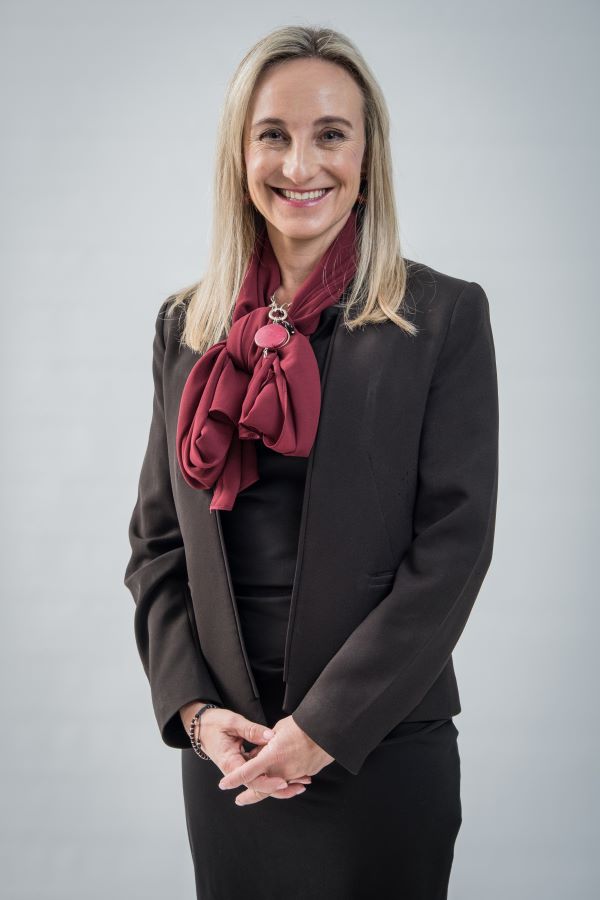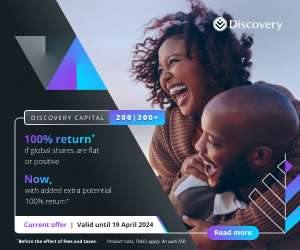
Florbela, what is the difference between advisory and discretionary investing?
Advisory refers to someone that gives advice. It usually relates to financial advisors who have a Category I licence. They can recommend funds that they think are suitable based on risk profiling their clients but don’t manage the investments themselves.
Discretionary investing refers to someone in possession of a Category II licence – as the name suggests, discretionary fund managers (DFMs) have full discretion to manage portfolios within the parameters of an investment mandate. The investor signs an investment mandate upfront that governs the parameters within which the DFM needs to apply their skill. For example, the mandate might dictate the portfolio’s investment outcome (or benchmark), set a predetermined risk budget as well as stipulate the investment time horizon and targeted level of drawdowns.
The DFM will then need to make investment decisions to make sure that they optimise the investment portfolio to increase their probability of achieving the portfolio outcomes. This includes determining which asset classes to be invested in, what investment styles they need exposure to as well as selecting the appropriate underlying funds. Managing the portfolio and everything that comes with it (eg asset allocation calls, portfolio construction and any changes to these) are made by the DFM. Within the ambits of the mandate, the DFM makes decisions without having to confer with the client.
The DFM decides which investment managers have skill in different asset classes and whether to execute passively, actively, utilising smart-beta strategies or through a combination of these. At Equilibrium, we don’t believe that there is only one way to execute our portfolio construction process. And so, we prefer to use a combination of styles and strategies that we believe are best in each asset class, to build truly diversified portfolios for our clients.
Why should a financial planner use a DFM? What are the benefits?
Firstly, the investment market is very complex and there are so many different funds that it makes it difficult for advisors to be able to really evaluate the benefits of every fund, and this has been exacerbated by the constantly evolving legislative pressures. The introduction of the FAIS, FICA, RDR and POPIA legislation as well as the compliance burden on advisors has resulted in an increase in the costs of running their practices and personal time. By partnering with a DFM, the advisor frees themselves up to spending more time on giving clients advice.
When Equilibrium partners with a financial advisor, we try to understand what their challenges are and how they give advice. We pride ourselves in building portfolios that are closely aligned to the advisor’s value proposition
There are also benefits that a Category II licence offers that a Category I licence cannot. The Category II licence allows us to implement changes across all investors in a particular portfolio simultaneously. Whereas an advisor needs to get signed switch forms from each client, we literally make the changes at the touch of a button. Another advantage comes from the consolidated reports that we produce for advisors which look through to the underlying holdings with each investment manager. This negates the need for advisors to rely on often out-of-date information provided in factsheets to try to calculate the total combined asset class exposure and the performance of their clients’ overall portfolio.
At Equilibrium, our clients have reaped the benefit of a reduction in fees over the past few years.
It’s often said that there is no such thing as a free lunch, but in investments, diversification is the only free lunch. At Equilibrium, we believe in building truly diversified portfolios, but we also believe in ensuring that we are not chasing investment performance at all costs. Our process allows us to make deliberate decisions around the level of drawdowns that we would be comfortable with over shorter time periods. For example, in our conservative portfolios, we are conscious that investors often can’t tolerate big capital losses. Although we want to outperform inflation and make sure that we are building real wealth for our clients, in these portfolios we allocate the risk budget to make sure that clients don’t lose more than 2% over any rolling 12-month period. This affects the amount of offshore and growth assets that we would be comfortable including in the portfolio. In these portfolios, we typically take less offshore exposure because the rand is volatile.
I believe this is probably one of the reasons why we haven’t seen our investors down-risking between portfolios during the past few years. And it’s also the reason that our clients have had a higher hit-rate than the average South African retail investor. In other words, their ability to achieve their personal investment goals has been better.
Lastly, there is often a fee benefit to partnering with a DFM. Investors should always look at the Total Investment Cost (TIC) they pay for any portfolio. If they are using a DFM, this would be calculated by combining the TIC of each of the funds they are invested in with the DFM or portfolio manager fee that the DFM charges for their services. Most of the larger DFMs have been quite successful at negotiating preferential pricing with the underlying investment managers, so that the total TIC is often very competitive with that of balanced funds.
At Equilibrium, our clients have reaped the benefit of a reduction in fees over the past few years. As our total assets under management have grown, so has our ability to negotiate better fees because many investment managers offer sliding fees or better fee classes for larger assets. Where we can negotiate preferential fees, we pass those directly and fully onto underlying clients. While each individual advisor can only negotiate fees based on their book size, we have the advantage of combining the assets of all the advisors for whom we manage assets, thereby giving us better scale.
Regulation in South Africa has forced advisors to revisit what they do. Please expand.
The Retail Distribution Review (RDR) was introduced to professionalise both the financial advisory and investment management industries. It is a great piece of legislation that has forced advisors to rethink their value proposition.
There are a portion of advisors who have chosen to focus on investment management as part of their value proposition, but they are not licensed to manage assets. Selecting funds and managing portfolios require completely different skills. What we have seen in the industry is an evolution of advice. There are advisors who have evolved from being generalists (ie advising on risk, funeral, health, tax and investments) to focusing on their investment book as well as investment advisors evolving into wealth businesses offering more holistic advice to high-net-worth clients and often extending this to inter-generational solutions.
From a Treating Customers Fairly perspective, clients are all treated the same at the same time, which is a big advantage of partnering with a DFM.
And there are others who have identified an opportunity to diversify their earnings stream and have obtained a Category II licence allowing them to be advisors as well as investment managers. Many other advisors realised that they didn’t have the time or expertise to manage assets and decided to focus on what they do well (give advice) and rather partnered with a DFM to manage their clients’ assets. If that partnership is right, it brings a lot of value to the advisor.
The partnership allows the advisor to outsource the investment side to an investment manager. An investment manager who has a discretionary mandate, like Equilibrium, actively manages a portfolio on a day-to-day basis. It is up to us to decide what the appropriate asset classes and time frames are and to select underlying funds or investments appropriate to that mandate.
For example, a conservative portfolio has a shorter time horizon, so we invest in more conventional asset classes and mandate some of the fund managers to have a capital protection or preservation mindset. In aggressive portfolios, we take more risk because we have the time and the investors in these portfolios don’t mind a bit of volatility as their focus might be more on capital growth than on capital protection.
All investors in a portfolio get the benefit of decisions on the same day under a Category II licence. From a Treating Customers Fairly perspective, clients are all treated the same at the same time, which is a big advantage of partnering with a DFM.
The complexity of legislation and the fact that FAIS has professionalised the industry has led advisors to partner with DFMs who manage assets on behalf of the clients. It is up to the DFM to understand what is happening in the market and how different asset classes are performing.
What is the potential growth of the DFM sector?
We have seen huge growth in the DFM industry both locally and internationally as advisors grapple with the increased demands on their time. The legislation requires Category II licence holders to have the necessary expertise to operate as such. This requires specific skill and training but also necessitates the required resourcing within a DFM to offer all the services.
Although the market has grown, not all DFMs are equal. Some manage only in-house funds, some specialise in limited areas and others offer the full spectrum of Category II services from strategic and tactical asset allocation, manager research, strategy optimisation, quantitative tools, full attribution reporting and portfolio construction to MANCO services.
There are Category II licences out there that aren’t fully resourced. In these instances, they often appoint a sub-investment advisor (or DFM) to help them in the areas where they may not have the necessary skill. For example, they might have asset allocation skills but lack portfolio construction skills or they might be good at identifying equity managers but are not skilled in the fixed income or hedge fund market. I think there is going to be consolidation.
Another factor is how many of those are not necessarily true DFMs in that they do not manage third-party assets. In South Africa, there are maybe 12 true independent DFMs who manage on behalf of independent financial advisors and six of them are large. There are a lot of what I call in-house DFMs, who manage for their own network group type assets, that’s a little bit different.
Do you think that there should be more consolidation?
There is no doubt that the discretionary fund market is growing so if the percentage of assets that are managed by DFMs is increasing and advisors are starting to outsource more to DFMs, I think there will be opportunity for new entrants. But running an investment management business isn’t easy.
The challenge is in identifying what each investment manager is good at and then determining whether their fund’s benchmark is aligned to the outcome that an investor is looking for.
Professional skills and tools are expensive and attracting assets is critical. One of the best tools to secure assets is a proven track record.
I guess the challenge for new entrants will be in their differentiators. We need to remember that adding new model portfolios to platforms is costly and often leads to operational inefficiencies. Platforms are becoming increasingly hesitant to keep adding funds that don’t attract assets. This puts pressure on all investment managers and DFMs to make sure that they are bringing in the assets.
For advisors and investors, more choice makes it even more difficult to evaluate the best option. In South Africa, we are spoilt for choice. We have phenomenal investment managers. The challenge is in identifying what each investment manager is good at and then determining whether their fund’s benchmark is aligned to the outcome that an investor is looking for.
We have started to see consolidation across investment managers reaching an all-time high over the past few years, and the same is true of platforms. I believe there will be a point at which the industry will become too saturated and we will start to see consolidation. There is an opportunity for certain new entrants, but size is very important. DFMs with large investment teams but small assets are often not profitable. Investment teams cost money to run. They need sizeable assets, and I would argue that if they’re trying to compete with the larger DFMs, unless they are niche, you may find consolidation in that space. So, the small houses trying to compete with the larger independent DFMs are probably under pressure.
Is the DFM’s service to the advisor worth the cost? Do DFMs generate investment alpha?
If they are providing the benefits that the advisor is looking for then I would argue yes, but they should provide the service at an appropriate fee. There are a range of fees that DFMs charge and it is important to understand what you are getting for that fee. Just like you would evaluate an investment manager on their performance, you should evaluate whether your DFM’s portfolios are performing. Traditional investment managers and DFMs add value after fees so it is essential to look at the after-fee experience rather than before fees.
An advisor needs to evaluate the level of benefits they receive. Are you getting strategic and tactical asset allocation, manager research, portfolio construction or is your DFM only giving you a couple of these?
Certainly, professional DFMs add value. It is difficult to compare them because not all of them have funds and fund of funds.
The DFM fee cannot be looked at in isolation, you need to combine the DFM and the underlying portfolio manager fees and compare the total to what you would pay if you bought the funds directly. The DFM market has grown so the ability to negotiate preferential fees with underlying investment managers has improved. If you compare the DFMs’ total investment charges to the charges that retail investors could get going directly to underlying funds, you will find that you are getting very good value for money. A DFM does charge a fee for this professional investment service, but it is not that fee in isolation – it is the total investment charge that needs to be compared and then the performance after all those fees.
You need to look at how your DFM is performing. Are they generating alpha? You should compare this to how a traditional manager generates alpha. It is important to understand what you’re getting. Whether using a DFM or a fund, is the benchmark aligned to your objective as an investor? If you are looking to out-perform inflation, you need to ask yourself is that DFM, single manager or multi-manager portfolio giving you what you are looking for or is the benchmark completely misaligned?
Certainly, professional DFMs add value. It is difficult to compare them because not all of them have funds and fund of funds. Many execute through model portfolios and there isn’t really a formal benchmark survey for that. The DFM survey produced by The Collaborative Exchange is a start but certainly not enough. Not all DFMs participate and some participants do not include their full range of portfolios. I would love to see a more formal industry survey with strict minimum criteria similar to the institutional surveys produced by some of the asset consulting firms. Just like there are good investment managers and some not so good investment managers, I believe the same is true of the DFM industry, not only in South Africa but globally.
Equilibrium Investment Management (Pty) Ltd (Equilibrium) (Reg. No. 2007/018275/07) is an authorised financial services provider (FSP32726) and part of Momentum Metropolitan Holdings Limited, rated B-BBEE level 1.













